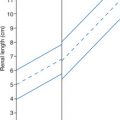Chapter 1. Fundamentals
Patient Preparation
Patient preparation (prep) instructions for each type of sonographic examination are available from a variety of publications (see Appendix A). Here are some tips on patient prep:
Upper abdomen
• Examinations performed later than the early morning may be significantly compromised by increasing amounts of air in the bowel (some air is swallowed while talking).
• Diabetic patients should be done as early in the day as possible; the patient may need to eat and drink immediately after the scan is completed, even while still in the examination room.
• Abdomen and pelvis sonograms scheduled for the same patient on the same day: it is extremely important that the patient understand the two separate preparations (if the full urinary bladder prep is used) and that the examinations may not be completed in one appointment time.
Gallbladder
• If the patient did not follow the fasting prep instructions the result may be a nondiagnostic examination that must be repeated.
• Smoking can cause the gallbladder to contract even when the patient has fasted.
Renal/urinary system
• The hydration level of the patient can affect the sonographic appearance of the kidneys (the renal medulla is generally more visible when the patient is hydrated).
• Overhydration of the patient (seen with the full urinary bladder prep) may lead to findings of pseudo or transient hydronephrosis.
Pelvis (female)
• Some protocols call for performing the transabdominal scan using whatever fluid is in the bladder at that time and then performing an endovaginal scan (after the patient voids) to obtain the required images.
Pregnancy
• The full urinary bladder examination may improve visualization of the lower uterine segment but may also create or mask cervical or placenta conditions. Using whatever fluid is in the urinary bladder may be more beneficial.
Pediatric patient
• Sonograms generally follow the same preparations as adult examinations, but fasting time is reduced or may not be needed.
• An emergency sonogram examination for any organ, structure, or area does not require any patient preparation.
Equipment and Technical Factors
The sonographer should have an in-depth knowledge of ultrasound physics and instrumentation (equipment hardware and software) to efficiently and accurately operate the ultrasound unit. Consult the technical publication(s) supplied with the unit or contact the applications support provided by the equipment manufacturer for clarification or instruction on equipment usage. Here are some tips regarding equipment and technical factors:
• The ultrasound unit should have appropriate software and transducers for all the applications performed in a clinical setting.
• Curved linear transducers work well for many types of upper abdominal examinations, but a vector transducer can use the intercostal spaces to avoid rib artifacts and increase sound beam access to the liver, spleen, and kidneys (depending on the patient’s body habitus).
Stay updated, free articles. Join our Telegram channel

Full access? Get Clinical Tree




